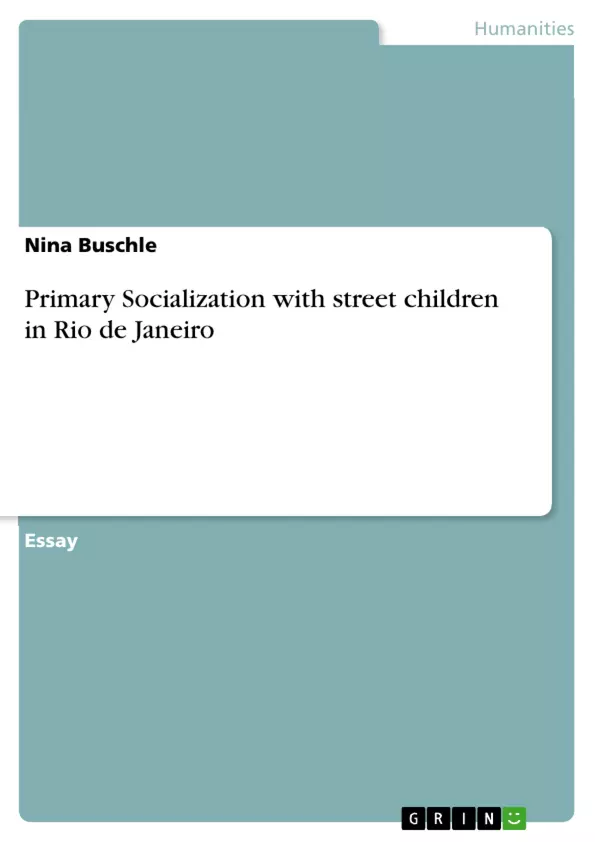“An upper-class child may learn the “facts of life” at an age when a lower-class child has mastered the rudiments of abortion technique. Or, an upper-class child may experience his first stirrings of patriotic emotion about the time his lower-class contemporary first experiences hatred of the police and everything they stand for.” 1 This quotation symbolizes the subject of my essay: I will delve into the term of Berger/Luckmann’s Primary Socialization in “The social construction of reality”. I want to compare their idea/perception of the ideal primary socialization of a child within the society with the current situation of street children in Rio de Janeiro, Brazil. It is important to know a little bit about the historical background of Brazil to understand why the social levels differ so greatly. I will also try to explain possible consequences and perspectives of these children. I chose this subject because I grew up in Rio de Janeiro. I learned to love this country, but I could also recognize the immense injustice rampant in this country. Especially in my situation, as a person who comes from a “good" and safe family, I asked myself since I was a little child: Why do I have so much and those children nothing? [...]
Table of Contents
- Introduction
- Resume / Abstract of "The Social Construction of Reality"
- Primary Socialization
- Secondary Socialization
- Brazil in the past or Development of current situation of street children
- Rio de Janeiro today
- Street Children in Rio de Janeiro
- Reasons for an unsuccessful primary socialization of potential street children
- Conclusion
Objectives and Key Themes
This essay aims to examine the concept of primary socialization as defined by Berger and Luckmann in their work "The Social Construction of Reality" and to explore its implications for street children in Rio de Janeiro. By analyzing the historical context of Brazil, the essay aims to understand the factors contributing to the current situation of street children and the challenges they face.
- Primary socialization and its impact on individual development
- The social construction of reality and its relevance to social inequalities
- The historical and social context of Brazil and its impact on street children
- The challenges and consequences of unsuccessful primary socialization
- The role of cultural and social factors in shaping individual identities and opportunities
Chapter Summaries
- Introduction: This chapter introduces the topic of primary socialization and its relevance to the situation of street children in Rio de Janeiro. It uses a quote to illustrate the differences in life experiences between children from different social backgrounds and sets the context for the essay's exploration of the concept of primary socialization.
- Resume / Abstract of "The Social Construction of Reality": This chapter provides a summary of Berger and Luckmann's key arguments in "The Social Construction of Reality." It highlights the concept of social construction of reality, the role of language and signs in shaping our understanding of the world, and the process of institutionalization and legitimation.
- Primary Socialization: This chapter delves into the concept of primary socialization as outlined by Berger and Luckmann. It explains the process of internalizing the values, norms, and behaviors of society and the role of parents and other significant others in shaping a child's identity.
- Secondary Socialization: This chapter examines secondary socialization and its relationship to primary socialization. It discusses how new information and experiences are integrated into the previously established framework of primary socialization and the role of institutions like schools in shaping individual development.
- Brazil in the past or Development of current situation of street children: This chapter provides a historical overview of Brazil, focusing on the legacy of slavery and its impact on the social and economic conditions of the country. It explores the historical roots of the street children phenomenon and the challenges they have faced over time.
Keywords
This essay explores the concept of primary socialization, social construction of reality, street children, Brazil, Rio de Janeiro, historical context, social inequalities, and cultural factors. The analysis focuses on the challenges and consequences of unsuccessful primary socialization in the context of a complex social and historical reality.
- Arbeit zitieren
- Nina Buschle (Autor:in), 2005, Primary Socialization with street children in Rio de Janeiro , München, GRIN Verlag, https://www.grin.com/document/71061



